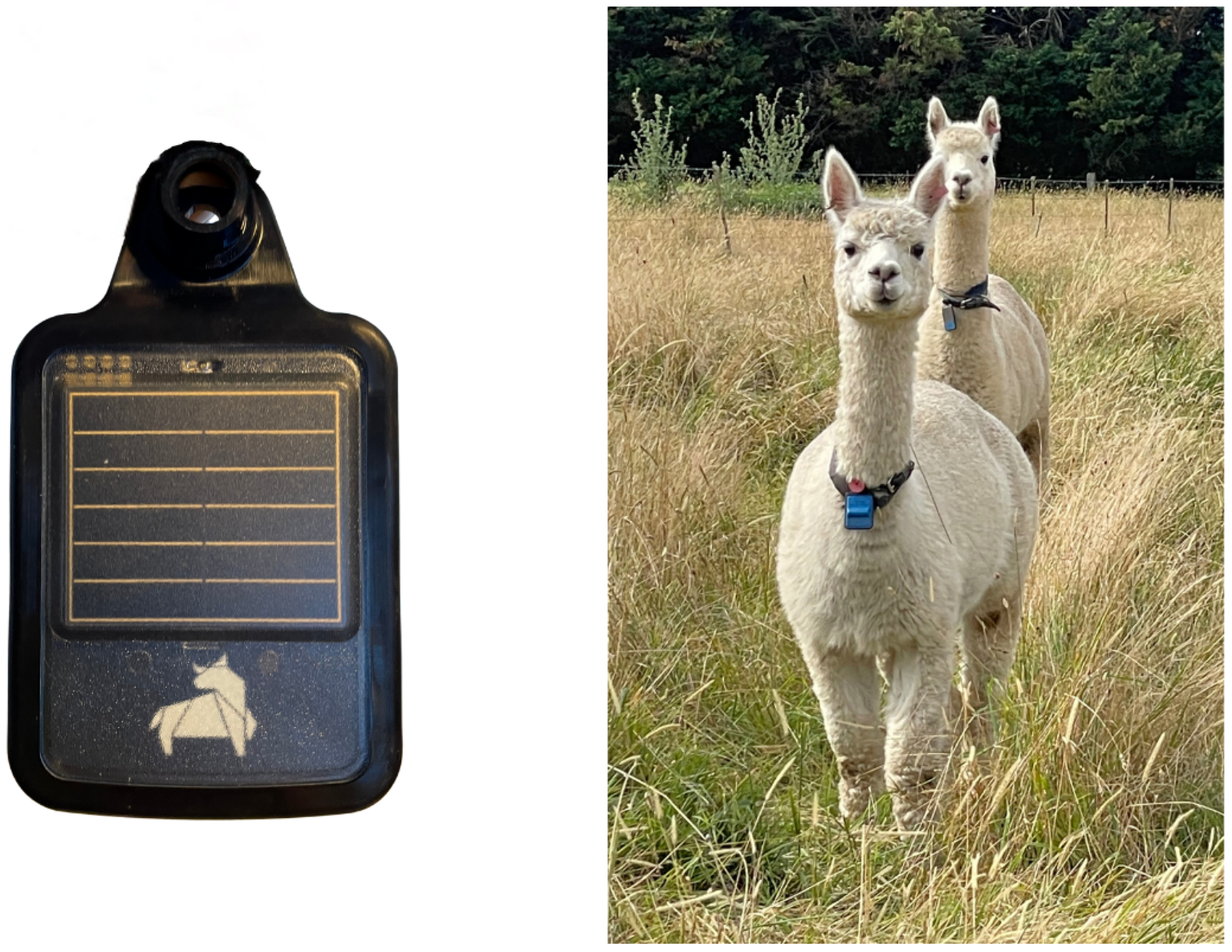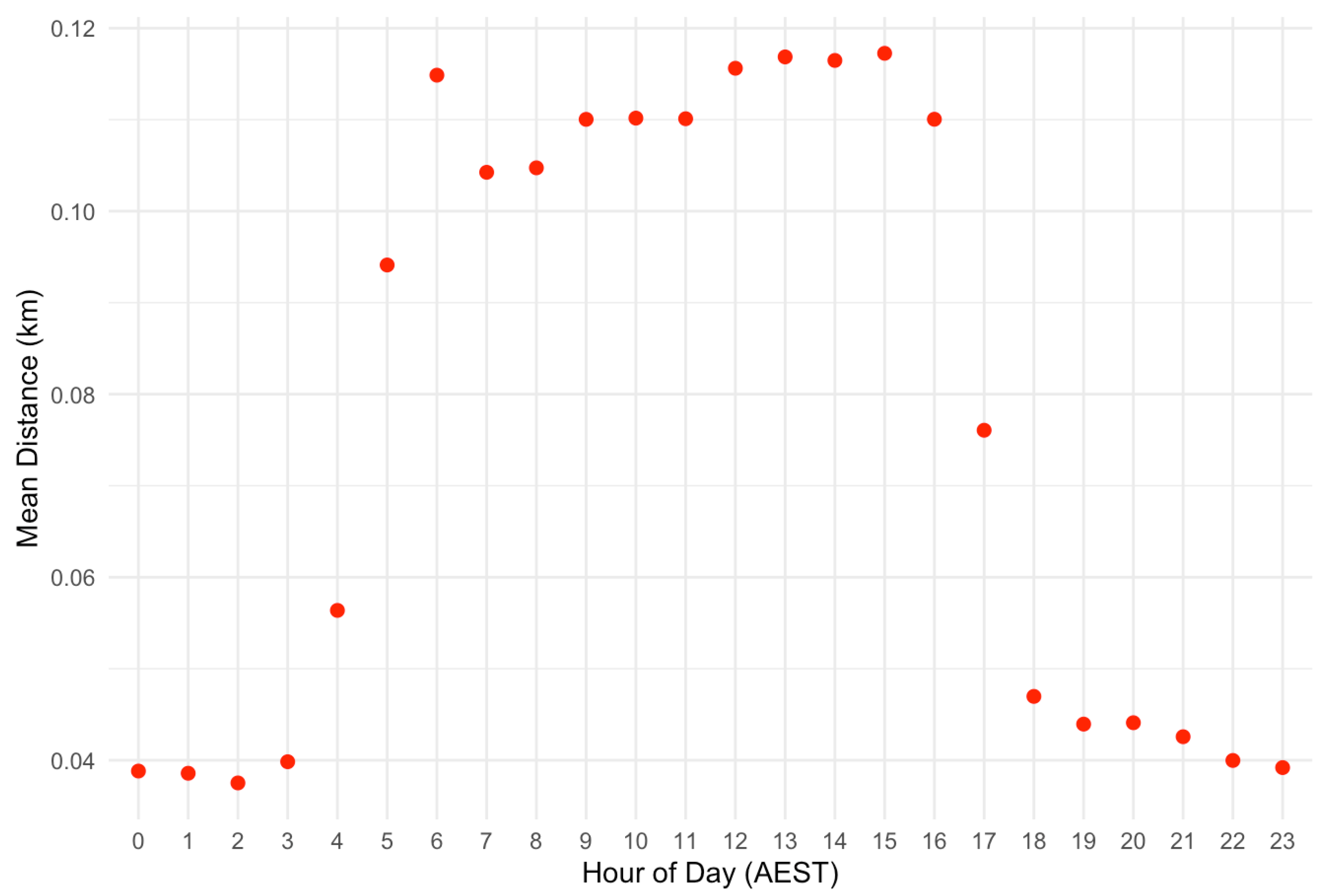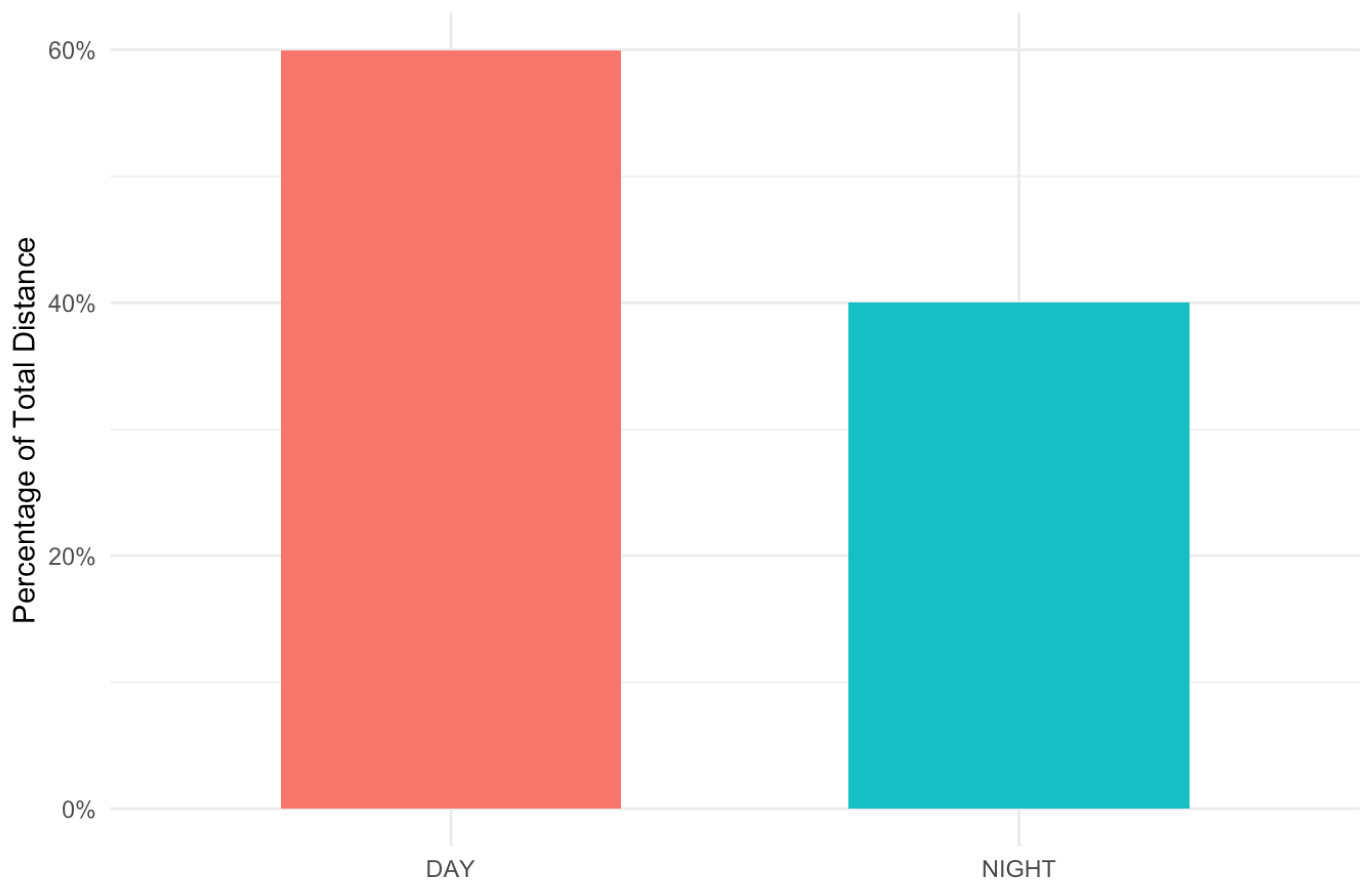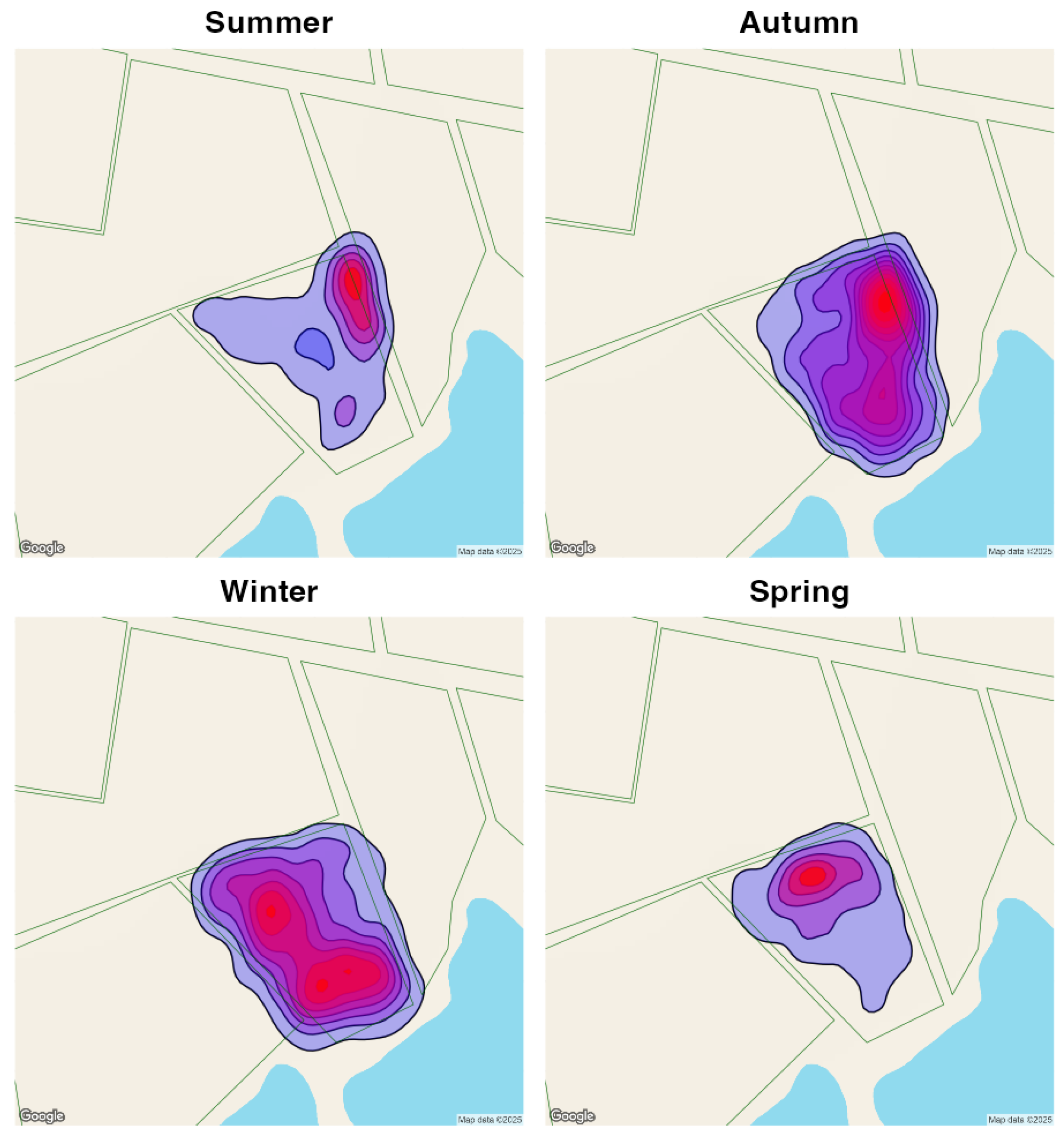Using Real-Time GNSS Tracking Tags to Monitor Alpaca Activity in an Australian Extensive Production System
Abstract
1. Introduction
2. Materials and Methods
2.1. Animal Usage and Location
2.2. Herd Management
2.3. Real Time Tracking Tags
2.4. Spatio-Temporal Patterns
2.5. Statistics
3. Results
3.1. Alpaca Health
3.2. Alpaca Activity Levels
3.3. Spatio-Temporal Patterns
4. Discussion
4.1. Alpaca Activity in an Extensive Production System
4.2. Effect of Real-Time Tracking Technology on Animal Health
4.3. Research Learnings and Future Opportunities
5. Conclusions
Author Contributions
Funding
Institutional Review Board Statement
Informed Consent Statement
Data Availability Statement
Acknowledgments
Conflicts of Interest
Abbreviations
| BCS | Body Condition Score |
| GNSS | Global Navigation Satellite Systems |
| GPS | Global Positioning System |
References
- Tomkiewicz, S.M.; Fuller, M.R.; Kie, J.G.; Bates, K.K. Global positioning system and associated technologies in animal behaviour and ecological research. Philos. Trans. R. Soc. B Biol. Sci. 2010, 365, 2163–2176. [Google Scholar] [CrossRef]
- Riaboff, L.; Poggi, S.; Madouasse, A.; Couvreur, S.; Aubin, S.; Bédère, N.; Goumand, E.; Chauvin, A.; Plantier, G. Development of a methodological framework for a robust prediction of the main behaviours of dairy cows using a combination of machine learning algorithms on accelerometer data. Comput. Electron. Agric. 2020, 169, 105179. [Google Scholar] [CrossRef]
- Riaboff, L.; Couvreur, S.; Madouasse, A.; Roig-Pons, M.; Aubin, S.; Massabie, P.; Chauvin, A.; Bédère, N.; Plantier, G. Use of predicted behavior from accelerometer data combined with GPS data to explore the relationship between dairy cow behavior and pasture characteristics. Sensors 2020, 20, 4741. [Google Scholar] [CrossRef]
- Tzanidakis, C.; Tzamaloukas, O.; Simitzis, P.; Panagakis, P. Precision Livestock Farming Applications (PLF) for Grazing Animals. Agriculture 2023, 13, 288. [Google Scholar] [CrossRef]
- Clark, C.E.; Lyons, N.A.; Millapan, L.; Talukder, S.; Cronin, G.M.; Kerrisk, K.L.; Garcia, S.C. Rumination and activity levels as predictors of calving for dairy cows. Animal 2015, 9, 691–695. [Google Scholar] [CrossRef]
- Davison, C.; Michie, C.; Hamilton, A.; Tachtatzis, C.; Andonovic, I.; Gilroy, M. Detecting heat stress in dairy cattle using neck-mounted activity collars. Agriculture 2020, 10, 210. [Google Scholar] [CrossRef]
- Ermetin, O.; Karadağ, Y.; Yıldız, A.K.; Karaca, F.; Tüfekçi, H.; Tufan, Y.; Kayaalp, A.N. Use of a Global Positioning System (GPS) to Manage Extensive Sheep Farming and Pasture Land. J. Hell. Vet. Med. Soc. 2022, 73, 4441–4448. [Google Scholar] [CrossRef]
- Plaza, J.; Palacios, C.; Abecia, J.A.; Nieto, J.; Sánchez-García, M.; Sánchez, N. GPS monitoring reveals circadian rhythmicity in free-grazing sheep. Appl. Anim. Behav. Sci. 2022, 251, 105643. [Google Scholar] [CrossRef]
- Fogarty, E.S.; Manning, J.K.; Trotter, M.G.; Schneider, D.A.; Thomson, P.C.; Bush, R.D.; Cronin, G.M. GNSS technology and its application for improved reproductive management in extensive sheep systems. Anim. Prod. Sci. 2015, 55, 1272–1280. [Google Scholar] [CrossRef]
- Herlin, A.; Brunberg, E.; Hultgren, J.; Högberg, N.; Rydberg, A.; Skarin, A. Animal welfare implications of digital tools for monitoring and management of cattle and sheep on pasture. Animals 2021, 11, 829. [Google Scholar] [CrossRef] [PubMed]
- Matthews, P.T.; Barwick, J.; Doughty, A.K.; Doyle, E.K.; Morton, C.L.; Brown, W.Y. Alpaca field behaviour when cohabitating with lambing ewes. Animals 2020, 10, 1605. [Google Scholar] [CrossRef]
- Hlimi, A.; El Otmani, S.; Elame, F.; Chentouf, M.; El Halimi, R.; Chebli, Y. Application of Precision Technologies to Characterize Animal Behavior: A Review. Animals 2024, 14, 416. [Google Scholar] [CrossRef]
- Boughey, I.; Hall, E.; Bush, R. Australian Alpaca Demographics and Management: A National Survey. Animals 2024, 14, 2861. [Google Scholar] [CrossRef] [PubMed]
- Dias-Silva, T.P.; Filho, A.L.A. Sheep and goat feeding behavior profile in grazing systems. Acta Sci. Anim. Sci. 2021, 43, e51265. [Google Scholar] [CrossRef]
- Champion, R.A.; Rutter, S.M.; Penning, P.D.; Rook, A.J. Temporal variation in grazing behaviour of sheep and the reliability of sampling periods. Appl. Anim. Behav. Sci. 1994, 42, 99–108. [Google Scholar] [CrossRef]
- Boughey, I.; Hall, E.; Bush, R. Daytime Paddock Behaviour of Alpacas Raised in an Australian Extensive Production System: A Pilot Study. Animals 2025, 15, 2357. [Google Scholar] [CrossRef]
- Raggi, L.A.; Jiliberto, E.; Urquieta, B. Feeding and foraging behaviour of alpaca in northern Chile. J. Arid Environ. 1994, 26, 73–77. [Google Scholar] [CrossRef]
- Orihuela, A. Review: Management of livestock behavior to improve welfare and production. Animal 2021, 15, 100290. [Google Scholar] [CrossRef]
- Grandin, T. Reducing Handling Stress Improves Both Productivity and Welfare. Prof. Anim. Sci. 1998, 14, 1–10. [Google Scholar] [CrossRef]
- R Core Team. R: A Language and Environment for Statistical Computing; R Foundation for Statistical Computing: Vienna, Austria, 2024. [Google Scholar]
- Kahle, D.; Wickham, H. ggmap: Spatial visualization with ggplot2. R J. 2013, 5, 144–161. [Google Scholar] [CrossRef]
- Pebesma, E. Simple features for R: Standardized support for spatial vector data. R J. 2018, 10, 439–446. [Google Scholar] [CrossRef]
- Microsoft Corporation. Microsoft Excel; Microsoft Corporation: Redmond, WA, USA, 2018. [Google Scholar]
- Sinnott, R. Virtues of the Haversine. Sky Telesc. 1984, 68, 159. [Google Scholar]
- Odintsov Vaintrub, M.; Levit, H.; Chincarini, M.; Fusaro, I.; Giammarco, M.; Vignola, G. Review: Precision livestock farming, automats and new technologies: Possible applications in extensive dairy sheep farming. Animal 2021, 15, 100143. [Google Scholar] [CrossRef]
- Lachica, M.; Barroso, F.G.; Prieto, C. Seasonal variation of locomotion and energy expenditure in goats under range grazing conditions. J. Range Manag. Arch. 1997, 50, 234–238. [Google Scholar] [CrossRef][Green Version]
- Scheibe, K.M.; Berger, A.; Langbein, J.; Streich, W.J.; Eichhorn, K. Comparative analysis of ultradian and circadian behavioural rhythms for diagnosis of biorhythmic state of animals. Biol. Rhythm Res. 1999, 30, 216–233. [Google Scholar] [CrossRef]
- Kapustka, J.; Budzyńska, M.; Kapustka, J.; Budzyńska, M. Behaviour traits of alpacas based on pasture and stable observations. Wiad. Zootech. 2018, 3, 128–136. [Google Scholar]
- Sharp, P.; Knightz, T.W.; Hodgson, J. Grazing behaviour of alpaca and sheep. Proc. N. Z. Soc. Anim. Prod. 1995, 55, 183–185. [Google Scholar]
- Feldt, T.; Schlecht, E. Analysis of GPS trajectories to assess spatio-temporal differences in grazing patterns and land use preferences of domestic livestock in southwestern Madagascar. Pastoralism 2016, 6, 5. [Google Scholar] [CrossRef]
- Horn, J.; Isselstein, J. How do we feed grazing livestock in the future? A case for knowledge-driven grazing systems. Grass Forage Sci. 2022, 77, 153–166. [Google Scholar] [CrossRef]
- Parlato, M.C.; Valenti, F.; Porto, S.M. GIS-based methodology for tracking the grazing cattle site use. Heliyon 2024, 10, e33166. [Google Scholar] [CrossRef]
- Nyamuryekung’e, S.; Cibils, A.F.; Estell, R.E.; VanLeeuwen, D.; Spiegal, S.; Steele, C.; González, A.L.; McIntosh, M.M.; Gong, Q.; Cao, H. Movement, activity, and landscape use patterns of heritage and commercial beef cows grazing Chihuahuan Desert rangeland. J. Arid Environ. 2022, 199, 104704. [Google Scholar] [CrossRef]
- Jørgensen, G.H.; Andersen, I.L.; Holand, Ø.; Bøe, K.E. Differences in the spacing behaviour of two breeds of domestic sheep (Ovis aries) - influence of artificial selection? Ethology 2011, 117, 597–605. [Google Scholar] [CrossRef]
- Dodd, C.L.; Pitchford, W.S.; Hocking Edwards, J.E.; Hazel, S.J. Measures of behavioural reactivity and their relationships with production traits in sheep: A review. Appl. Anim. Behav. Sci. 2012, 140, 1–15. [Google Scholar] [CrossRef]
- Pauler, C.M.; Isselstein, J.; Berard, J.; Braunbeck, T.; Schneider, M.K. Grazing Allometry: Anatomy, Movement, and Foraging Behavior of Three Cattle Breeds of Different Productivity. Front. Vet. Sci. 2020, 7, 494. [Google Scholar] [CrossRef]
- Mancuso, D.; Castagnolo, G.; Porto, S.M. Cow Behavioural Activities in Extensive Farms: Challenges of Adopting Automatic Monitoring Systems. Sensors 2023, 23, 3828. [Google Scholar] [CrossRef]
- Lamanna, M.; Bovo, M.; Cavallini, D. Wearable Collar Technologies for Dairy Cows: A Systematized Review of the Current Applications and Future Innovations in Precision Livestock Farming. Animals 2025, 15, 458. [Google Scholar] [CrossRef]




| Season | Average Daily Distance (km) | SE |
|---|---|---|
| Summer | 1.07 | 0.007 |
| Autumn | 0.43 | 0.015 |
| Winter | 1.57 | 0.029 |
| Spring | 1.56 | 0.013 |
Disclaimer/Publisher’s Note: The statements, opinions and data contained in all publications are solely those of the individual author(s) and contributor(s) and not of MDPI and/or the editor(s). MDPI and/or the editor(s) disclaim responsibility for any injury to people or property resulting from any ideas, methods, instructions or products referred to in the content. |
© 2025 by the authors. Licensee MDPI, Basel, Switzerland. This article is an open access article distributed under the terms and conditions of the Creative Commons Attribution (CC BY) license (https://creativecommons.org/licenses/by/4.0/).
Share and Cite
Boughey, I.; Hall, E.; Bush, R. Using Real-Time GNSS Tracking Tags to Monitor Alpaca Activity in an Australian Extensive Production System. Agriculture 2025, 15, 1839. https://doi.org/10.3390/agriculture15171839
Boughey I, Hall E, Bush R. Using Real-Time GNSS Tracking Tags to Monitor Alpaca Activity in an Australian Extensive Production System. Agriculture. 2025; 15(17):1839. https://doi.org/10.3390/agriculture15171839
Chicago/Turabian StyleBoughey, Imogen, Evelyn Hall, and Russell Bush. 2025. "Using Real-Time GNSS Tracking Tags to Monitor Alpaca Activity in an Australian Extensive Production System" Agriculture 15, no. 17: 1839. https://doi.org/10.3390/agriculture15171839
APA StyleBoughey, I., Hall, E., & Bush, R. (2025). Using Real-Time GNSS Tracking Tags to Monitor Alpaca Activity in an Australian Extensive Production System. Agriculture, 15(17), 1839. https://doi.org/10.3390/agriculture15171839






